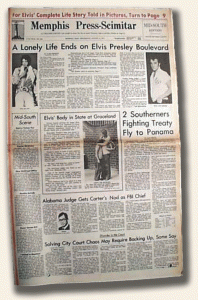A novel way to keep the money coming…
August 29, 2009 by TimHughes · Leave a Comment
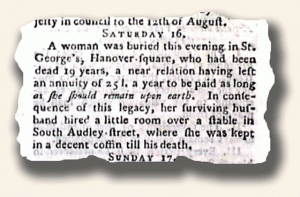 The following is taken from the “Gentleman’s Magazine” issue of July, 1768, published in London. Perhaps a distant ancestor of Edgar Allan Poe?
The following is taken from the “Gentleman’s Magazine” issue of July, 1768, published in London. Perhaps a distant ancestor of Edgar Allan Poe?
Quotes defining history…
July 13, 2009 by Morris Brill · 2 Comments
When I was fourteen years old (ah, so many years ago) I acquired an interest in quotations. By the time I was twenty-one I had read the entire collection of Bartlett’s Famous Quotations and recorded each of the quotes that had significance for me. I have since added to my list of favorites.
Coincidentally, when I was twenty-one, I also bought my first collectable newspaper; The Assassination of President John F. Kennedy.
Many years ago I concluded that often a quote, paired with a specific headline, added profound meaning to the headline. The right quotation enhanced the moral or social significance of the headline. Often, the right quote was able to capture the ‘essence’ of the headline.
Quotes, like newspapers, unite us with the past. They provide us with the thoughts of those who came before us. Additionally, within a newspaper, you may find text that contains a statement that later becomes a famous quote.
For instance: the Boston Gazette of December 26, 1805 contains a report on the Battle of Trafalgar. The article quotes British Admiral Horatio Nelson as saying, “England expects that every man will do his duty.” And we all know of President Franklin Roosevelt’s quote in his inaugural acceptance speech in 1933, “There is nothing to fear but fear itself,” which can be found on the front page of many newspapers of the time.
Of course, each individual would select different quotes to pair with a headline. I believe that the quotes a person prefers are a reflection of that person’s personal social background, religious background, education, and political persuasion.
With that said, and with your indulgence, I would like to share with you a very small sample of my pairings.
Headline: Treaty of Peace – Pennsylvania Packet – 11/08/1783
Quote: “What a free society offers to the individual is much more than what he would be able to do if only he were free.” – F.S. Hayek
Headline: Death of Benjamin Franklin – The Gentleman’s Magazine – 06/01/1790
Quote: “It is sweet to serve one’s country by deeds, and it is not absurd to serve her by words” – Sallust
Headline: Death of President Washington – The True American – 01/01/1800
Quote: “A patriot must always be ready to defend his country against his government” – Edward Abbey
Headline: Queen Victoria Coronation – Main Farmer/Journal of Useful Arts – 08/07/1838
Quote: “Uneasy is the head that wears a crown” – William Shakespeare
Headline: This “Flying Machine” Flies – Philadelphia Press – 12/19/1903
Quote: “I think for months and years. Ninety-nine times, the conclusion is false. The hundredth time I am right” – Albert Einstein
Headline: Life Terms in Prison for Leopold and Lobe – Los Angeles Evening Herald – 02/04/1924
Quote: “Being brilliant is no great feat if you respect nothing” – Johann Wolfgang von Goethe
Headline: Death Takes Stalin’s Reign – Syracuse Herald-Journal – 06/06/1954
Quote: “O, it is excellent to have a giant’s strength! But it is tyrannous to use it like a giant.” – William Shakespeare
Headline: Eichmann Convicted – Los Angeles Mirror – 12/11/1961
Quote: “The belief in a supernatural source of evil is not necessary; men alone are quite capable of every wickedness.” – Joseph Conrad
Headline: A Lonely Life Ends on Elvis Presley Boulevard – Memphis Press Scimtar – 08/17/1977
Quote: “It is loneliness that makes the loudest noise. This is true of men as of dogs.” – Eric Hoffer
Thank you for attention and interest.
Morris Brill
Why does my newspaper look as if it came from a book?
April 30, 2009 by GuyHeilenman · Leave a Comment
 This is a common question many newcomers ask upon their 1st encounter with a rare newspaper from nearly every era (Revolutionary War, Civil War, Old West, and even Birthday/Day-You-Were-Born issues, to name a few). Whether it is the rough left spine present from the issue being removed from a larger volume, or the consecutive numbering which results in only the first issue printed during the year to have a “page 1”, a novice’s immediate (and logical) reaction is that the issue must have come from a book and therefore must be a reprint. However, the truth is actually the opposite. Such signs are good indicators that the issue is likely authentic. To understand this, what is needed is a knowledge of how historic newspapers and magazines were handled up to as late as the 1960’s.
This is a common question many newcomers ask upon their 1st encounter with a rare newspaper from nearly every era (Revolutionary War, Civil War, Old West, and even Birthday/Day-You-Were-Born issues, to name a few). Whether it is the rough left spine present from the issue being removed from a larger volume, or the consecutive numbering which results in only the first issue printed during the year to have a “page 1”, a novice’s immediate (and logical) reaction is that the issue must have come from a book and therefore must be a reprint. However, the truth is actually the opposite. Such signs are good indicators that the issue is likely authentic. To understand this, what is needed is a knowledge of how historic newspapers and magazines were handled up to as late as the 1960’s.
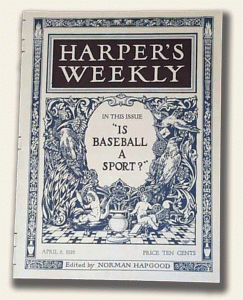 Many publishers of early newspapers started numbering their pages from 1 at the start the year and continued with the consecutive numbering throughout the year. This made it very easy to reference content. Examples of early well-known titles which did this are Harper’s Weekly, The War, Gentleman’s Magazine, Niles’ Register, and Leslie’s Illustrated, to name a few. Although this gave the newspapers a book effect, early readers would not have given this another thought. As far as the spine residue/disbinding evidence (which gives the appearance that the issue came from a book) is concerned, nearly every institution which held rare newspapers bound them together at the end of each year for protection & permanent storage in libraries. Almost all newspapers through the 1960’s were held in this manner. Your local library likely holds its early newspapers in this form. Two resources which may alleviate any concerns you might have related to this issue are the Library of Congress’ Newspaper Division & the American Antiquarian Society. HistoryBuff.com also provided additional information regarding this topic.
Many publishers of early newspapers started numbering their pages from 1 at the start the year and continued with the consecutive numbering throughout the year. This made it very easy to reference content. Examples of early well-known titles which did this are Harper’s Weekly, The War, Gentleman’s Magazine, Niles’ Register, and Leslie’s Illustrated, to name a few. Although this gave the newspapers a book effect, early readers would not have given this another thought. As far as the spine residue/disbinding evidence (which gives the appearance that the issue came from a book) is concerned, nearly every institution which held rare newspapers bound them together at the end of each year for protection & permanent storage in libraries. Almost all newspapers through the 1960’s were held in this manner. Your local library likely holds its early newspapers in this form. Two resources which may alleviate any concerns you might have related to this issue are the Library of Congress’ Newspaper Division & the American Antiquarian Society. HistoryBuff.com also provided additional information regarding this topic.
Editorial policy (?) and the potential impact upon an issue’s collectibility…
April 11, 2009 by GuyHeilenman · Leave a Comment
The following are a few thoughts by Morris Brill (guest contributor) concerning slight differences in the printing of the Declaration of Independence within the London Chronicle (dated August 17, 1776) vs. the printing within the Gentleman’s Magazine (dated August, 1776):
Recently on Ebay two different sellers offered a printing of the Declaration of Independence in the Gentleman’s Magazine. I also noted your offering of the Declaration within the London Chronicle.
I (Morris) noted, while reading the text of Gentleman’s Magazine, as photographed on Ebay, a particular sentence in which two words were missing and substituted with a line, i.e. ___________
 The sentence is as follows:
The sentence is as follows:
“A prince, whose character is thus marked by every act which may define a tyrant, is unfit to be the ruler of a free people.”
In the Gentleman’s Magazine the words ” prince” and “tyrant” are deleted.
I find it interesting that although the Gentleman’s Magazine and the the London Chronicle are both British that one paper printed the words prince and tyrant, yet the other did not.
To me, the deletion of the two words certainly diminishes the historic value of the printing as it appeared in the Gentleman’s Magazine, although I would not pass up the opportunity to own this paper. Perhaps it has to do with an opposing editorial policy, or the political persuasion of the two publishers.
Morris
Note: If anyone is aware of the formal policy which led to the deletion of certain words within the Gentleman’s Magazine, please share your insight with the rare newspaper community.
Contest Winners… “In Search for the Unusual and Bizarre”
March 18, 2009 by GuyHeilenman · Leave a Comment
AND the winners are…
A few weeks ago the History’s Newsstand Blog ran a contest asking members to contribute unusual and/or bizarre articles they’ve discovered through the years. Many unique entries were submitted, and the voting, done by both members and staff, resulted in a photo finish. The results:
1st Place ($100 website gift certificate) -Phil Howland who submitted a St. Louis Missouri Republican, June 22, 1826, regarding “A MISSOURI TRAPPER”
2nd Place ($50 website gift certificate) – Joe Rainone, who submitted THE DAY’S DOINGS, February 10, 1872, regarding General Custer and Miss Spotted Tale”
3rd Place ($25 website gift certificate) -Erik Anderson, who submitted The Gentleman’s Magazine, dated March, 1732, regarding “Vampires”
The entire text all of entries may be viewed at:
“In Search for the Unusual and Bizarre”
Thanks to all those who took the time to submit an entry. Many members indicated by e-mail as to how much the enjoyed reading the entries. The MISSOURI TRAPPER:
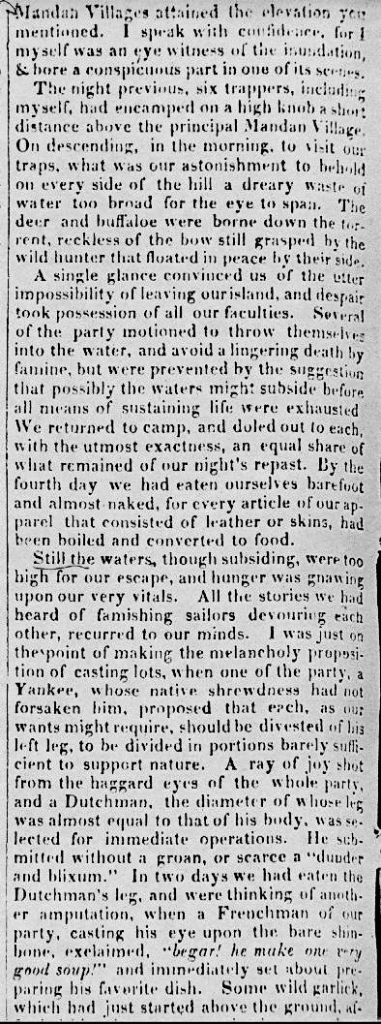
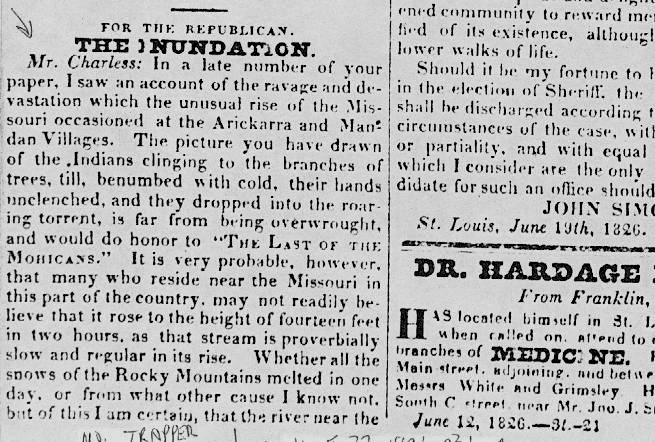

Most historic: The Declaration of Independence in your collection…
March 12, 2009 by TimHughes · 8 Comments
I’m not sure there is much of a contest for the “most historic event of the Revolutionary War”. Can anyone make a case for anything beyond the Declaration of Independence? We’d all love to hear from you if so.
 My experience is that this document is the most desired to have in an American newspaper, not just from this era but from the entire spectrum of American history. Well, an exception might be an issue of “Public Occurrences Both Foreign and Domestic“, the Sept. 25, 1690 newspaper printed in Boston which lasted but one day and of which only one copy is known to exist. I’d trade that remarkable find for a Declaration of Independence, but nothing else.
My experience is that this document is the most desired to have in an American newspaper, not just from this era but from the entire spectrum of American history. Well, an exception might be an issue of “Public Occurrences Both Foreign and Domestic“, the Sept. 25, 1690 newspaper printed in Boston which lasted but one day and of which only one copy is known to exist. I’d trade that remarkable find for a Declaration of Independence, but nothing else.
A year or so ago I was aware of a Philadelphia newspaper containing the Declaration of Independence which brought over $400,000 in auction. So much for the average collector adding an American printing to their collection, which is why interest has been heightened in British periodicals with the document.
And it did appear in at least several British magazines and newspapers. The popular “Gentleman’s Magazine” from London carried it in their August, 1776 issue as did the “Universal Magazine” and the “London Magazine“. The “Gentleman’s & London Magazine” carried the historic text in their September issue (note: the only American magazine in print in 1776, the “Pennsylvania Magazine”, carried the Declaration text in their July issue).
It’s curious that the “London Gazette” newspaper never printed the Declaration, likely for political reasons, but it did appear in the “London Chronicle” of August 17 as well as the “Edinburgh Evening Courant” issue of August 21. I suspect we’ve sold other British periodicals containing the Declaration through the years but their titles & dates escape me.
With American imprints containing the Declaration likely to remain out of reach for most collectors–but we always hope for that magical find–I would encourage consideration of printings in other periodicals. British titles are the best as there is no language barrier and they are from a country which had, should we say, a vested interest in the event. And their prices are still within the range of many collectors. The “Gentleman’s Magazine” printing are typically under $4000 when in inventory and the “London Chronicle” is still in four figures. I suspect French, Dutch or German printings would have less interest to the average collector, although their prices would be lower when they become available.
The key for any nice newspaper collection is having a period printing, meaning a report from the time it happened. A printing of the Declaration in 1799 or 1826 just wouldn’t have the collector appeal of a July, August, or even September printing from 1776.
How desirable is owning a period printing of the Declaration of Independence to you, and what date, title, or condition compromises are you willing to make to add such an issue to your collection?
Waiting to be discovered…
February 9, 2009 by TimHughes · Leave a Comment
The History Channel has sparked much interest in events of the past which otherwise have gone unnoticed through the years. Whether it’s a biography of notable name, a little-known yet significant war battle, or a political event which had notable consequences years later, it’s not uncommon for us to receive calls from hopeful collectors wanting a period account of the event. Many times we are successful in the search, other times not.
Occasionally present-day events noting an anniversary or discovery spark similar interest. We have noticed a significant interest in Abraham Lincoln material with the approach of the 200th anniversary of his birth. And the very recent discovery of the British ship “H.M.S. Victory” got even us intrigued about the possibility of finding a 1744 newspaper or magazine reporting its loss.
As a bit of background, a report dated February 5, 2009 from the “Best Syndication News” service brought this event into the 21st century with its breaking news reading:
“The HMS Victory ship sunk in stormy seas back in 1744 but it wasn’t until this week, when an American company called Odyssey discovered what they call “the most significant shipwreck discovery in history.” The HMS Victory was a warship that had a crew of around 1,100 that died when it went underwater. The estimated treasures with gold coins and artifacts could be worth potentially $1 billion. The Odyssey company is undergoing a legal battle to allow them to recover the treasures and artifacts. Because the HMS Victory is a military ship she is the property of the British government according to the laws of marine salvaging.”
As luck would have it we were successful. Keeping in mind that there were no survivors, details were obviously sketchy back then, but both the October and November issues of the “Gentleman’s Magazine” reflected upon the disaster.
All of us, as collectors, literary keep history on our shelves. Who knows when the next discovery might relate to an innocuous report in one of your newspapers. Have you discovered in one of your issues an item brought to light by present-day events? Such finds are always fascinating–it’s part of the intrigue of the hobby.
Before they became famous…
January 29, 2009 by TimHughes · 2 Comments
Part of the fun in collecting newspapers is finding reports in newspapers or magazines of the day about a person or event before it or they became famous. Typically such reports are very inconspicuous and brief, which adds to the excitement in making such a discovery.
 Such finds are not uncommon in this hobby. We have sold many issues of the installation in the Philadelphia State House steeple that which would become the physical manifestation of freedom –the Liberty Bell–as reported in a Gentleman’s Magazine of 1753. There are several mentions of political neophyte Abraham Lincoln from the 1830’s & 1840’s, well before he would be thrust into American history with the advent of the Civil War. Mentions of Davy Crockett from before his heroic death at the Alamo can still be found.
Such finds are not uncommon in this hobby. We have sold many issues of the installation in the Philadelphia State House steeple that which would become the physical manifestation of freedom –the Liberty Bell–as reported in a Gentleman’s Magazine of 1753. There are several mentions of political neophyte Abraham Lincoln from the 1830’s & 1840’s, well before he would be thrust into American history with the advent of the Civil War. Mentions of Davy Crockett from before his heroic death at the Alamo can still be found.
A recent find is equally as intriguing and perhaps more so as it is no small report. The SCIENTIFIC AMERICAN magazine of February 22, 1902 has most of a page taken up with a report of Wilbur Wright “…of Dayton, Ohio…” and his experiments with flight and includes not just one but five photos of his early machines. This was some 22 months before he and his brother would make their historic flight in Kitty Hawk, North Carolina, which would change the world forever.
This issue has languished on our warehouse shelves for many years only to be discovered by accident. Such are the joys of collecting! I hope all of you have experienced some exciting finds unnoticed by others.
What reports of historical people or events have you found which predate their greater moment of significance? Feel free to share.
Collecting the Revolutionary War on a budget…
March 28, 2013 by TimHughes · 2 Comments
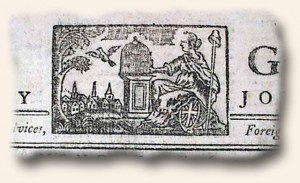 I would argue that beyond the Civil War, the era of American history which evokes the most interest among our collectors is unquestionably the Revolutionary War. With a cast of characters who still rank among the most memorable in history—Washington, Adams, Hancock, Jefferson, Henry, Franklin, Paine, and more—and a plot, which if it were not true history would serve as an excellent screenplay for an exciting movie—an oppressed, energized people seek to break free from the reigns of oppression and dominance from abroad—it is easy to see how the events of the Revolutionary War continue to intrigue and offer a foundation upon which to reflect as today’s world grapples with many of the same issues despite the 230+ years which distance us from those notable events.
I would argue that beyond the Civil War, the era of American history which evokes the most interest among our collectors is unquestionably the Revolutionary War. With a cast of characters who still rank among the most memorable in history—Washington, Adams, Hancock, Jefferson, Henry, Franklin, Paine, and more—and a plot, which if it were not true history would serve as an excellent screenplay for an exciting movie—an oppressed, energized people seek to break free from the reigns of oppression and dominance from abroad—it is easy to see how the events of the Revolutionary War continue to intrigue and offer a foundation upon which to reflect as today’s world grapples with many of the same issues despite the 230+ years which distance us from those notable events.
And what could be better than experiencing those events just as those who lived through them? Newspapers offer that opportunity. Genuine issues, once held and read by those who lived through those turbulent days before being relegated to the back shelves of libraries, are now part of the inventory of Hughes Rare & Early Newspapers. And at prices which might surprise many (see Revolutionary War issues for $60 and under), as a hobby which is relatively unknown to the collecting world has yet to cause demand and scarcity to drive prices beyond the means of the average collector. Of course, there are still many that fall into the category of what we refer to as, “The Best of the Best – Revolutionary War Edition“.
Of significance is that British titles, which offer excellent coverage of all American events given their role in attempting to placate the demands of the Americans while maintaining control of their colonies, allow ownership of battle reports of the war for under $100, with 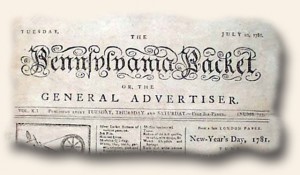 some very notable events in the $200-$300 range. American newspapers remain among the most desired but their scarcity is reflected in their prices. With a collection of the “Pennsylvania Evening Post” which included the Declaration of Independence bringing $600,000 in auction recently, it would amaze many that the same document is available in London’s “Gentleman’s Magazine” issue of August, 1776 (took news 3-4 weeks to traverse the Atlantic) for under $4,000. Other disproportionate prices between British and American newspapers entice many to gravitate to the British titles while prices and availability remain attractive.
some very notable events in the $200-$300 range. American newspapers remain among the most desired but their scarcity is reflected in their prices. With a collection of the “Pennsylvania Evening Post” which included the Declaration of Independence bringing $600,000 in auction recently, it would amaze many that the same document is available in London’s “Gentleman’s Magazine” issue of August, 1776 (took news 3-4 weeks to traverse the Atlantic) for under $4,000. Other disproportionate prices between British and American newspapers entice many to gravitate to the British titles while prices and availability remain attractive.
The “London Chronicle” is one of the better British titles in reporting the Revolutionary War. From the Battle of Lexington and Concord, to Bunker Hill, Battle of New York, Saratoga, Washington crossing the Delaware, treason of Benedict Arnold, Guilford Court House, to Cornwallis’ surrender at Yorktown, this newspaper offers coverage which equals the American newspaper accounts. In fact many British reports were taken verbatim from American newspapers. Of equal quality in report news of the day was the “Edinburgh Evening Courant” from Scotland as I have found all events of the Revolutionary War to be reported in this title as well. Other UK titles which covered the war include “The Glocester Journal”, “Aris’s Birmingham Gazette”, the “Edinburgh Advertiser” and the “Glasgow Mercury” to name a few.
But perhaps the best and most available title of the Revolutionary War period would be the “Gentleman’s Magazine” from London, it having a long printing history from 1731 to the 20th century so it encompasses not just the Revolutionary War in great detail by the entire scope of American history. As an added treat this title typically included one of more plates within each issue, which included maps as well. And during the years of the Revolutionary War were found many maps of American colonies, battle sites as well as large foldout maps showing the entire scope of the united colonies at that time. The maps alone have found a keen interest among collectors, separate from the issues in which they were stored for over 200 years. As is true with the British titles mentioned, “Gentleman’s” included all notable events and documents, including the Articles of Confederation, the Causes and Necessity For Taking Up Arms, all major battles of the war thru the treaty between Washington and Cornwallis, and even the document by King George III which officially ended the war. And all the major names of the war from both the British and American sides have found their way into the pages of “Gentleman’s Magazine”.
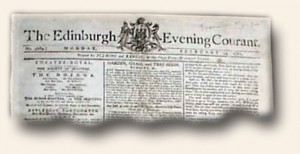 American titles are available as well. Some of the more rare would be those from the South which are virtually impossible to find, and when they do surface their prices are beyond the means of most collectors. Some of the more commonly found titles would be the “Pennsylvania Evening Post” from Philadelphia, the “Pennsylvania Ledger” “Boston Gazette” (which featured an engraving by Paul Revere in the masthead), “The Pennsylvania Gazette” and “Pennsylvania Packet” among others. And dipping back a few years before the outbreak of the war, when tensions were building with much evidence in the newspapers of the day, the “Pennsylvania Chronicle” and the “Boston Chronicle” offer excellent insight into events of the day from the years 1767-1769 for under $200 for most issues.
American titles are available as well. Some of the more rare would be those from the South which are virtually impossible to find, and when they do surface their prices are beyond the means of most collectors. Some of the more commonly found titles would be the “Pennsylvania Evening Post” from Philadelphia, the “Pennsylvania Ledger” “Boston Gazette” (which featured an engraving by Paul Revere in the masthead), “The Pennsylvania Gazette” and “Pennsylvania Packet” among others. And dipping back a few years before the outbreak of the war, when tensions were building with much evidence in the newspapers of the day, the “Pennsylvania Chronicle” and the “Boston Chronicle” offer excellent insight into events of the day from the years 1767-1769 for under $200 for most issues.
Regardless of your interest in the Revolutionary War, whether it be the famous names that came to prominence, the battles of the war, or a focus on a singular event or locality, genuine newspapers of the day are available for the collector. It is a hobby with limitless possibilities, and offers a unique opportunity to literally hold history in your hands.



